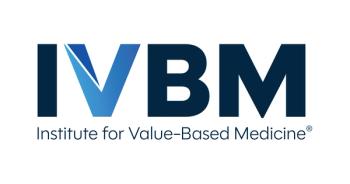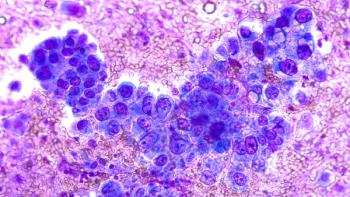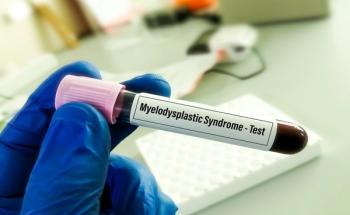
- October 2021
- Volume 27
- Issue 7
The Promise of Liquid Biopsies for Cancer Diagnosis
In recent years, the clinical development of liquid biopsies for cancer, a revolutionary screening tool, has created great optimism.
The discovery of circulating tumor cells (CTCs) during an autopsy more than 150 years ago1,2 was followed by the discovery of other signifi cant circulating cancer elements, such as cell-free DNA (cfDNA)3 and finally circulating tumor DNA.4,5
Defined as a test to search for cancer cells or pieces of DNA from tumor cells in a blood sample,6 liquid biopsies can serve a variety of purposes, including:
• diagnosing cancers earlier than traditional means such as radiology or imaging
• customizing treatment for detected diseases through genotyping
• identifying mechanisms of resistance to therapies
• measuring minimal residual disease or remaining disease after treatment
• assessing for cancer relapse or resistance to administered treatment
Although standard tissue biopsies generally involve invasive procedures to detect a tumor, liquid biopsies are performed on peripheral blood which is easy to access, allowing for more widespread use, particularly in patients who cannot have surgery. As a result, the use of liquid biopsies can reduce the time to treatment based on tumor detection, improve the efficiency of medical staff and resources, and can be used to screen more diseases. Liquid biopsies can also avoid some of the potential complications of traditional biopsies, including risk of tumor spread, injury to surrounding tissue, or severe bleeding.
Many tumors display regional heterogeneity (diverse tumor cells) that can limit the ability of a single, tissue-based biopsy to access the full molecular profile of the tumor. In contrast, liquid biopsies may detect tumor DNA shed from numerous sites within the tumor and thus provide a more comprehensive genomic picture. In so doing, the clinicians can be more informed in the use of molecularly targeted therapies. Similarly, liquid biopsies may bring a more efficient and innovative method to select patients for clinical trials, as the broader analysis of mutations can help guide appropriate therapy. Liquid biopsies can also be used for patient segmentation or inclusion and for patient monitoring.
Level of Use and Estimates Regarding Adoption
Some research reports say that the liquid biopsy market will be valued in at $6 billion by 2030.7 The United States is currently in the lead for development due to higher per capita health care expenditures and the awareness of improved early cancer detection benefits.
Liquid biopsies have been used for diagnosing non–small cell lung cancer (NSCLC)8 and screening or as a companion diagnostic (a test that indicates a patient could benefit from a specific therapy) for other types of cancers such as gastrointestinal, colorectal, breast, prostate and ovarian cancer.
When used as a cancer detection tool for segments of the general population, there is speculation that liquid biopsy may improve the outcomes of diagnosis. Evidence shows that a more realistic approach is to use this screening technique on high-risk patients who have a personal or family history of cancer.9 Currently, liquid biopsies are most commonly used as a complementary technique to standard tissue biopsies, primarily in academic centers and procedures in community practices. Standard tissue biopsies are still the mainstay for cancer diagnosis, but for those patients who are unable to undergo or whose tumors are not amenable to invasive biopsies, liquid biopsies hold promise.
Challenges Faced by Clinical Adoption of Liquid Biopsy
Although more and more molecular diagnostic tests are being performed, they still must reach 2 important milestones: development of standards for their adoption and clinical validation. In addition, a few areas include2,10:
• complex biological data need to be developed and validated in studies that can generate clinically useful outcomes in order to trigger appropriate treatment decisions
• the deeper understanding of cancer biology and biomarkers, otherwise risks for false-negative or false-positive results of liquid biopsies are possible
• the number of liquid biopsy tests or methods that have received regulatory approval is low compared to the pool of tests developed by various companies10
• uncertainty or limitation of procedure reimbursement11
A review by Douglas et al that appeared in Journal of the National Comprehensive Cancer Network11 highlights some fragmented reimbursement approaches by payers but also provides a comprehensive view for companies that are looking for cancer detection solutions.
How Can Liquid Biopsy Move Forward?
In 2020, the FDA approved FoundationOne Liquid CDx designed by Foundation Medicine, which can detect alterations in all solid tumors with specific diagnostics.12 Analyzing more than 300 genes and their signatures, this sequencing test can be used to guide therapy selection and clinical trial options for patients. Also in 2020, the FDA approved another next-generation sequencing (NGS) test, Guardant360 CDx, which is able to detect EGFR mutations in cfDNA of some patients affected by NSCLC.13 However, before liquid biopsies can become an integrated part of regular oncologic practices, physician education is key to ensure that they understand the utility and limitations of liquid biopsies. This type of education enables clinicians to have a comprehensive understanding of how to implement utilize this technology most meaningfully for their patients.
In this next year, data from prospective studies must show that liquid biopsies deliver benefits to patients beyond being non-invasive, such as increasing quality-adjusted life-years.
A number of companies have taken steps to make the widespread adoption of liquid biopsies a reality. In 2016, the cancer diagnostics company GRAIL became an important name in biotech. With $100 million in funding from its parent company, Illumina, and another $2 billion raised from private funding sources, GRAIL has set a bold objective to improve patient outcomes through early detection of cancer.14,15 It has combined data science and the most advanced genetic sequencing technologies to detect cancer. Illumina agreed to bring GRAIL back into its umbrella by purchasing it for $8 billion.
As Evidence-Based Oncology™ went to press, New York state regulators approved GRAIL’s multicancer screening test, Galleri, meaning it has achieved one of the most rigorous validation standards in the country for a laboratory developed test; the test is already available to some health systems.16-17
Conclusions
Large scale adoption of liquid biopsy screening tools will require further clinical evidence of clear benefits to patients and reductions in medical costs. The high complexity and diversity of coverage structures, especially in the private sector, will require clear guidelines regarding how test outcomes will affect clinical decision-making by providers. Ultimately, the future of liquid biopsy has the potential to increase diagnostic options and personalized care.
Author Information
Liz Kwo, MD, MBA, MPH, is a faculty lecturer at Harvard Medical School and physician entrepreneur. Jenna Aronson is a PhD candidate at MIT.
References
1. Ashworth TR. A case of cancer in which cells similar to those in the tumours were seen in the blood after death. Aust Med J. 1869;14:146.
2. Morgan TM. Liquid biopsy: where did it come from, what is it, and where is it going? Investig Clin Urol. 2019;60(3):139-141. doi: 10.4111/icu.2019.60.3.139
3. Leon SA, Shapiro B, Sklaroff DM, Yaros MJ. Free DNA in the serum of cancer patients and the effect of therapy. Cancer Res. 1977;37(3):646-650.
4. Diehl F, Schmidt K, Choti MA, et al. Circulating mutant DNA to assess tumor dynamics. Nat Med. 2008;14(9):985-990. doi:10.1038/nm.1789.
5. What is circulating tumor DNA and how is it used to diagnose and manage cancer? MedLine Plus. Updated July 28, 2021. Accessed September 15, 2021. https://medlineplus.gov/genetics/understanding/testing/circulatingtumordna/
6. National Cancer Institute. Liquid biopsy. Accessed August 18, 2021.
https://www.cancer.gov/publications/dictionaries/cancer-terms/def/liquid-biopsy
7. Liquid biopsy market size worth $5.96 billion by 2030. News release. GrandView Research. Published May 2018. Accessed September 13, 2021.
https://www.grandviewresearch.com/press-release/liquid-biopsy-market
8. cobas EGFR Mutation Test v2. FDA Website. Updated June 2, 2016. Accessed September 13, 2021. https://www.fda.gov/drugs/resourcesinformation-approved-drugs/cobas-egfr-mutation-test-v2
9. Chen M, Zhao H. Next-generation sequencing in liquid biopsy: cancer screening and early detection. Hum Genomics.2019;13(14). doi:10.1186/s40246-019-0220-8
10. Neumann MHD, Bender S, Krahn, Schlange T. ctDNA and CTCs in liquid biopsy—current status and where we need to progress. Comput Struct Biotechnol J. 2018;6:190-195. doi:10.1016/j.csbj.2018.05.002
11. Douglas MP, Gray SW, Phillips KA. Private payer and Medicare coverage for circulating tumor DNA testing: a historical analysis of coverage policies from 2015 to 2019. J Natl Compr Canc Netw. 2020;18(7):866-872. doi: 10.6004/jnccn.2020.7542.
12. FDA approves liquid biopsy, NGS companion diagnostic test for multiple cancers and biomarkers.. News release. FDA. November 8, 2020. Accessed September 13, 2021. https://www.fda.gov/drugs/resources-information-approved-drugs/fda-approves-liquid-biopsyngs-
companion-diagnostic-test-multiple-cancers-and-biomarkers
13. FDA approves first liquid biopsy next-generation sequencing companion diagnostic test. News release. FDA. Updated August 11, 2020. Accessed September 13, 2021. https://www.fda.gov/news-events/press-announcements/fda-approves-first-liquid-biopsy-next-generation-
sequencing-companion-diagnostic-test
14. Wasserman E. JPM: Illumina sees “holy grail market opportunity’ with $100M Series A for liquid biopsy spinoff. Fierce Biotech. January 11, 2016. Accessed September 13, 2021. https://www.fiercebiotech.com/medical-devices/jpm-illumina-sees-holy-grail-market-opportunity-100m-series-a-for-liquid-biopsy
15. Crichton D. Illumina buying cancer-screening spinout GRAIL in blockbuster $8B biotech deal. TechCrunch. September 21, 2020. Accessed September 16, 2021. https://techcrunch.com/2020/09/21/illumina-grail/
16. GRAIL announces first health system to offer Galleri, novel multi-cancer early detection blood test. News release. March 2, 2021. Accessed September 16, 2021. https://grail.com/press-releases/grail-announces-first-healthsystem-to-offer-galleri-novel-multi-cancer-early-detection-blood-test/
17. GRAIL receives New York State approval for Galleri, multi-cancer early detection blood test. News release. September 20, 2021. Accessed September 25, 2021. https://www.businesswire.com/news/home/20210920005514/en/GRAIL-Receives-New-York-State-Approvalfor-Galleri-Multi-Cancer-Early-Detection-Blood-Test
Articles in this issue
about 4 years ago
From the Editor-in-Chief: The Way Upabout 4 years ago
Building a Patient-Centered Cancer Center From the Ground Upabout 4 years ago
Dr David S. Hong: We Are Learning Every Day About Cellular TherapiesNewsletter
Stay ahead of policy, cost, and value—subscribe to AJMC for expert insights at the intersection of clinical care and health economics.








































